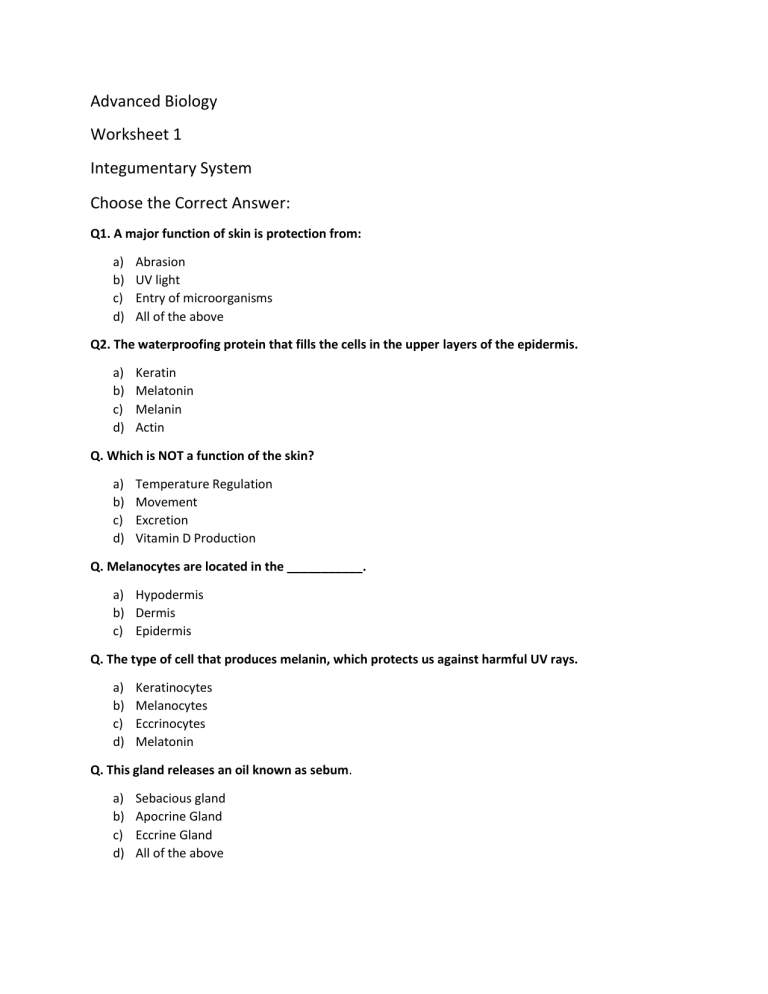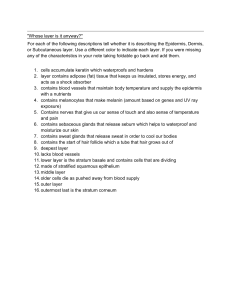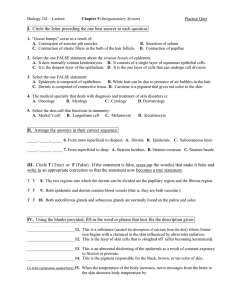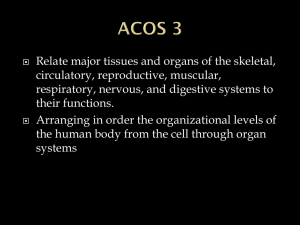
Advanced Biology Worksheet 1 Integumentary System Choose the Correct Answer: Q1. A major function of skin is protection from: a) b) c) d) Abrasion UV light Entry of microorganisms All of the above Q2. The waterproofing protein that fills the cells in the upper layers of the epidermis. a) b) c) d) Keratin Melatonin Melanin Actin Q. Which is NOT a function of the skin? a) b) c) d) Temperature Regulation Movement Excretion Vitamin D Production Q. Melanocytes are located in the ___________. a) Hypodermis b) Dermis c) Epidermis Q. The type of cell that produces melanin, which protects us against harmful UV rays. a) b) c) d) Keratinocytes Melanocytes Eccrinocytes Melatonin Q. This gland releases an oil known as sebum. a) b) c) d) Sebacious gland Apocrine Gland Eccrine Gland All of the above Q. What is the top layer of the skin called? a) b) c) d) Dermis Hypodermis Epidermis Subcutaneous Q. true or false freckles and moles are seen where melanin is concentrated in one spot a) true b) false Q. true or false ridges of the finger in the dermis papillary layer along with sweat pores leave a unique identifying film called a fingerprint a) true b) false Q. Nails are made out of what? a) Terminal b) Vellus c) Keratin Q. Where is the thickest skin located? a) b) c) d) Palm of hands Soles of feet Eye lid Both a and b Q. What is another name for the hypodermis? a) epidermis b) subcutaneous layer c) stratum basale Q. The top layer of the epidermis is made of: a) b) c) d) flat, dead keratinized cells melanin collagen healthy, living cells Q. In which of these layers are melanocytes found? a) Dermis b) Stratum basale c) Stratum Corneum Q. Which layer of the skin contains lots of adipose tissue and blood vessels? a) Dermis b) Epidermis c) Hypodermis Q. Melanin: a) b) c) d) Helps protect skin from UV radiation Is found in almost every human being Is responsible for skin color All of the above Q. Which of these events occur as a result of a decrease in body temperature? a) b) c) d) sweat is produced your nails turn red contraction of arrector pili muscles all of these Q. Which glands of the skin secrete an oily substance which helps keep your skin smooth and soft? a) b) c) d) Apocrine sweat glands merocrine sweat glands sebaceous glands none of the choices Q. Arrector pili muscles: a) b) c) d) are a part of your skeletal system assist in the production of sebum contract in response to frightening situations or cold weather cause sweat glands to contract Q. Which of the following is NOT part of the integumentary system? a) b) c) d) Skin Cartilage Nails Hair Q. Which type of burn is characterized by the epidermis and dermis being destroyed, leaving scar tissue behind? a) 1st degree burn b) 2nd degree burn c) 3rd degree burn Q. Caused by a complete lack of melanin: a) Dermatitis b) Albinism c) Melanitis Q. When your body temperature rises, these secrete water to the surface where heat is removed by evaporation. a) Sweat gland and duct b) Hair shaft c) Hair follicle Q. This provides your skin with strength and elasticity (as you age you lose this and skin may become looser) a) b) c) d) Keratin Dermis Collagen Melanin Q. This is produced at the Sebaceous gland and helps lubricate your skin; keeping it soft and pliable. a) b) c) d) Keratin Sebum Collagen Melanin Q. The deadliest type of skin cancer that comes from melanin-producing cells becoming cancerous: a) b) c) d) basal cell carcinoma squamous cell carcinoma malignant melanoma benign cancer Q. Which type of skin cancer is the most common? a) b) c) d) Basal cell carcinoma Squamous cell carcinoma Malignant melanoma none of the choices Q. What are the causes of skin cancer? a) UV radiation from the sun b) Genetics c) All the choices Q. Some of the dangers associated with severe burns include: a) b) c) d) tissue damage and cell death dehydration shock All of the choices Q. Which layer of skin is "A" referring to? a) b) c) d) Epidermis Dermis Hypodermis Melanin Q. To what layer of skin is letter "B" pointing? a) b) c) d) Epidermis Dermis Hypodermis Melanin Q. To what layer of skin is letter "C" pointing? a) b) c) d) Epidermis Dermis Hypodermis Melanin Q. To what structure is #1 pointing? a) b) c) d) Hair follicle Hair shaft Hair root Epidermis Q. To what structure is #3 pointing? a) b) c) d) Sweat gland and duct Sweat pore Arrector pili muscle Sebaceous oil gland Q. To what structure is #4 pointing? a) b) c) d) Sweat gland and duct Sweat pore Arrector pili muscle Sebaceous oil gland Q. The structure that holds the root of the hair firmly in place. a) b) c) d) Hair follicle Hair shaft Hypodermis Sweat pore Q. The epidermis receives nutrients from blood vessels located in the: a) b) c) d) Dermis Hypodermis Hair follicle Hair shaft Q. The vasculated area of skin is the: a) Dermis b) Epidermis c) Stratum basale Q. What causes acne? a) b) c) d) clogged sebaceous glands clogged apocrine glands clogged merocrine glands clogged sweat glands Q. Which layer of the skin does NOT contain blood vessels? a) epidermis b) hypodermis c) dermis Q. What cell produces a protein allows for waterproofing of the skin, nails, and hair? a) b) c) d) Keratinocytes Melanocytes Merkel Cells Langerhans cell Q. What layer of epidermis does cell division occur? a) b) c) d) stratum lucidum stratum basale stratum granulosum stratum corneum Q. The oldest cells of the epidermis will be found here a) b) c) d) Stratum Corneum Stratum Basale Stratum Spinosum Stratum Granulosum









